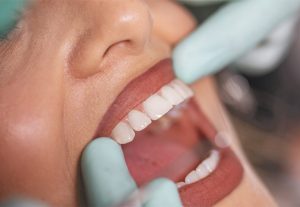By Dr. Amanda Rizner


Depending on the diagnosis, oral cancers can have a fifty percent survival rate after five years. On average, men are more susceptible than women. Even though detection may be more visible to the human eye than other malignancies, oral cancers come with a higher death rate due to diagnosis being made later in its development. This is because the initial stages often present with little to no symptoms that are recognizable until later stages.
Oral cancer can also present in various ways within the mouth and the symptoms may differ based on the specific location. It often manifests as a red or white lesion in the oral cavity that is non wipeable (meaning it cannot be wiped off by gauze or a towel). Its appearance can also include mouth ulcers that do not heal in a two-week period of time, loose teeth, and hard lumps or bumps that may cause difficulty chewing or swallowing. Squamous cell carcinomas are the most common form of oral malignancy and accounts for almost 90% of cases.
Other forms can include salivary gland tumors as well as melanomas.
One of the primary causes of oral cancer is tobacco use, whether it be smoking or chewing tobacco. There has also been an increase in popularity of smokeless tobacco, which has helped decrease lung cancer statistics, but has not yet shown to decrease the prevalence of oral cancers. Additionally, excessive alcohol consumption, prolonged sun exposure to the lips, and certain viral infections such as human papillomavirus (specifically HPV16) are also linked to an increased risk of developing oral malignancy. Cancer due to HPV has been increasing in prevalence in the past few years and is slowly becoming the leading cause in posterior oropharynx related cancer in people under 50. It is important to note that these risk factors are often interconnected, and individuals who engage in multiple risk behaviors face a higher likelihood of developing oral cancer.
Having your dentist check your oral cavity at your annual exam is one way to help diagnose oral cancer early. The dentist will look for any suspicious areas on the soft, hard tissue, and tongue. Routine xrays are also essential in diagnosing certain types of bone malignancy that has metastasized, or spread to other areas of the body. If any lesions are found, the dentist will usually refer you to an oral surgeon who is specialized in doing biopsies on these types of lesions for an accurate diagnosis.
Preventive measures are crucial in reducing a person’s risk. The most effective way to prevent oral cancer is to adopt a healthy lifestyle. This includes avoiding tobacco products in any form, moderating alcohol consumption, and practicing safe sun exposure by using lip balm with UV protection. Vaccination against HPV is another preventive measure, as certain strains of the virus are associated with an increased risk.
In summary, regular dental check-ups and screenings are essential for the early detection of oral cancer. Dentists are trained to identify suspicious lesions or abnormalities in the oral cavity during routine examinations. Early detection significantly improves the chances of successful treatment and recovery. Individuals should be proactive in scheduling regular dental visits, especially if they have risk factors such as tobacco or alcohol use.
(941) 529-0055
www.dentistryonfruitville.com
 Southwest Florida's Health and Wellness Magazine Health and Wellness Articles
Southwest Florida's Health and Wellness Magazine Health and Wellness Articles

